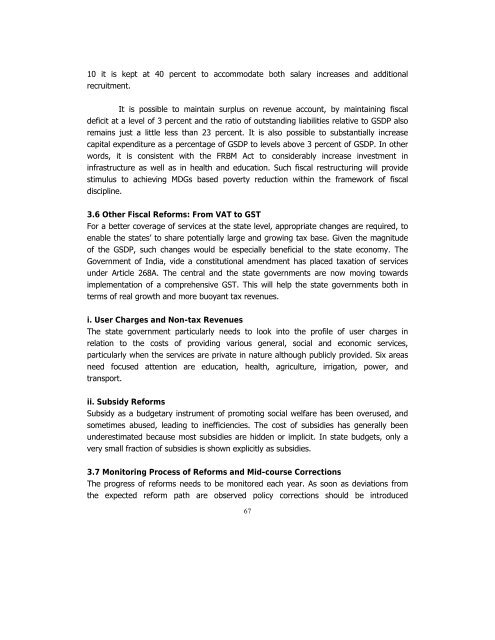POVERTY REDUCTION STRATEGY TN
Create successful ePaper yourself
Turn your PDF publications into a flip-book with our unique Google optimized e-Paper software.
10 it is kept at 40 percent to accommodate both salary increases and additional<br />
recruitment.<br />
It is possible to maintain surplus on revenue account, by maintaining fiscal<br />
deficit at a level of 3 percent and the ratio of outstanding liabilities relative to GSDP also<br />
remains just a little less than 23 percent. It is also possible to substantially increase<br />
capital expenditure as a percentage of GSDP to levels above 3 percent of GSDP. In other<br />
words, it is consistent with the FRBM Act to considerably increase investment in<br />
infrastructure as well as in health and education. Such fiscal restructuring will provide<br />
stimulus to achieving MDGs based poverty reduction within the framework of fiscal<br />
discipline.<br />
3.6 Other Fiscal Reforms: From VAT to GST<br />
For a better coverage of services at the state level, appropriate changes are required, to<br />
enable the states’ to share potentially large and growing tax base. Given the magnitude<br />
of the GSDP, such changes would be especially beneficial to the state economy. The<br />
Government of India, vide a constitutional amendment has placed taxation of services<br />
under Article 268A. The central and the state governments are now moving towards<br />
implementation of a comprehensive GST. This will help the state governments both in<br />
terms of real growth and more buoyant tax revenues.<br />
i. User Charges and Non-tax Revenues<br />
The state government particularly needs to look into the profile of user charges in<br />
relation to the costs of providing various general, social and economic services,<br />
particularly when the services are private in nature although publicly provided. Six areas<br />
need focused attention are education, health, agriculture, irrigation, power, and<br />
transport.<br />
ii. Subsidy Reforms<br />
Subsidy as a budgetary instrument of promoting social welfare has been overused, and<br />
sometimes abused, leading to inefficiencies. The cost of subsidies has generally been<br />
underestimated because most subsidies are hidden or implicit. In state budgets, only a<br />
very small fraction of subsidies is shown explicitly as subsidies.<br />
3.7 Monitoring Process of Reforms and Mid-course Corrections<br />
The progress of reforms needs to be monitored each year. As soon as deviations from<br />
the expected reform path are observed policy corrections should be introduced<br />
67

















